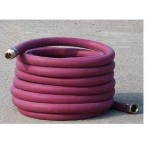 Quality hoses, an essential tool in any garden, are a worthy investment and should be stored properly during the winter to protect and preserve them. Hoses should be brought inside (e.g., garage, basement, shed) and stored, preferably on a shelf or hanger, rather than on the floor. It is essential to drain all water from the hose before storage to prevent freezing and mildew growth. Lift portions of the hose to a higher level to ensure water drains out of both ends. I carry the hoses to my elevated deck and ease them over the side to hang freely before dropping back to the ground, ensuring that they are completely free of water.
Quality hoses, an essential tool in any garden, are a worthy investment and should be stored properly during the winter to protect and preserve them. Hoses should be brought inside (e.g., garage, basement, shed) and stored, preferably on a shelf or hanger, rather than on the floor. It is essential to drain all water from the hose before storage to prevent freezing and mildew growth. Lift portions of the hose to a higher level to ensure water drains out of both ends. I carry the hoses to my elevated deck and ease them over the side to hang freely before dropping back to the ground, ensuring that they are completely free of water.
After the hose is drained, it should be coiled tightly (in a 24-36” diameter). Place the hose on the ground and, starting with the end that attaches to the hose bibb, begin coiling (there is a natural direction – if it doesn’t seem to wrap easily, try the opposite way). Coiling is easier when the hose is warm – so let is sit in the sun for a bit. (Since it is typically too cold outside to warm up my hoses by the time I get to store them, I let them sit on the basement floor – after they are drained – until they warm up, before coiling them.) Make sure all kinks are out of the hose before storing (or any other time). Tie the coiled hoses to neatly secure them with rope or Velcro ties. And, of course, remove and separately store hose nozzles and sprinklers.
Hoses are best stored off of the ground, on a hook or shelf where they get good air circulation. Otherwise fungus can develop and cause rotting. (Time and time again, when watering for folks, I have noticed a distinct mildew odor coming from a hose. Spraying fungus on or around plants cannot be beneficial.) It is also recommended to connect the male and female ends together to prevent insects from getting inside the hose (make sure the hoses are dry before doing this.)
This is the time to carefully insect your hoses for cracks or rotting. Breaks in hoses are easy and inexpensive to repair. It is worth investing it top quality hoses that are of ample size (length and diameter) and weight, that will not kink, and that will, instead, allow good water flow. You’ll enjoy a lifetime or very lengthy warranty on the better hoses – so save the packaging card. Before or after storage is a good time to inspect and replace washers. Worm washers are the most frequent cause of annoying and wasteful hose leaks.
Important note: evergreen trees and shrubs need to be watered through the end of December if they were planted during the year. Therefore, draining and hose storage may need to be delayed until that time, or stored temporarily in a garage or shed to be handy for watering use until that time, when they can be drained and stored finally. Lastly, if you shut off your outside water for the winter, please correctly drain your hose bibb – and even if you have a frost-free bibb, the hoses need to be brought in to a warmer place during the winter – and just taken out to use as needed.
Read more on this subject in my interview by a Washington Post writer for an article on garden hoses that was published in many newspapers, including the Hong Kong Standard. Here are Excerpts from the Article.
NOV
2012
